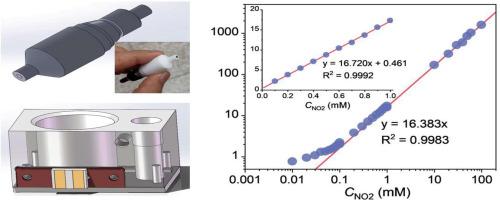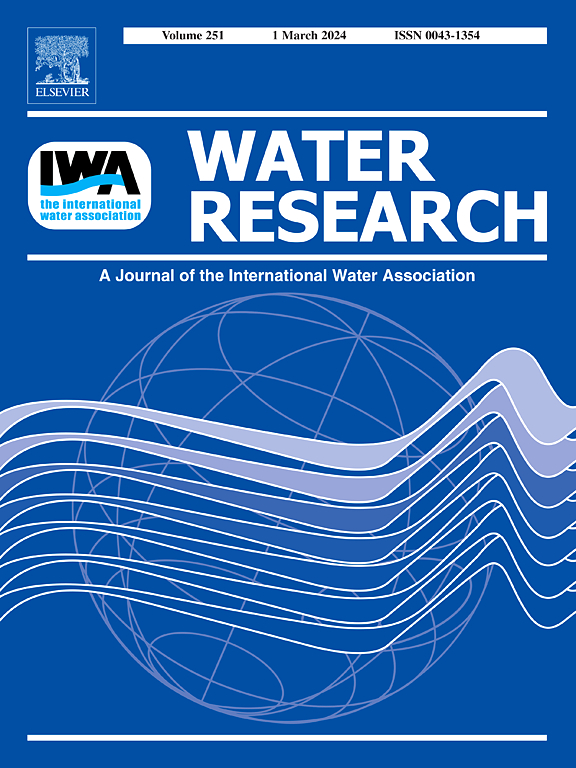Electrochemical Nitrite Sensing Using Mass Transfer Signal with a Catalyst-Free Small-Sized Rotating Disk Electrode for Wastewater Monitoring
IF 11.4
1区 环境科学与生态学
Q1 ENGINEERING, ENVIRONMENTAL
引用次数: 0
Abstract
Electrochemical nitrite sensing (ENS) is a competitive method for online monitoring in the intelligent control of biological nitrogen removal process. However, its popularity is extremely low due to complex wastewater interference and low sensor durability. Here, we developed a novel ENS method that utilizes the mass transfer signal (MTS) of the nitrite oxidation reaction (NOR), making detection accuracy dependent solely on mass transfer process. These features enabled us to design a catalyst-free, small-sized glassy carbon rotating disk electrode for accurate MTS determination with exceptional durability. The linearity of MTS versus nitrite concentration surpasses that of conventional differential pulse voltammetry and amperometry. The method has a wide linear range of 100 μM–100 mM, a detection limit of 28 μM, and a high sensitivity of 1638 μA mM-1 cm-2. Importantly, solution pH and coexisting buffers show no significant effect on MTS determinations as long as pH does not exceed 10. Excellent immunity to interference from ionic strength, temperature, COD, inert salts, metal ions, dissolved oxygen, and hydrogen peroxide was observed. While reducing substances capable of oxidation reactions do cause interference, they are not common in environmental samples. Finally, a self-designed detection system requiring a sample volume of 4 mL was used for wastewater testing. The results demonstrate good capability for nitrite detection during practical wastewater treatment processes, although relative error increases with the complexity and content of organic pollutants in the wastewater. Overall, this ENS method holds great potential for achieving rapid, stable, and low-cost nitrite sensing in environmental applications.

求助全文
约1分钟内获得全文
求助全文
来源期刊

Water Research
环境科学-工程:环境
CiteScore
20.80
自引率
9.40%
发文量
1307
审稿时长
38 days
期刊介绍:
Water Research, along with its open access companion journal Water Research X, serves as a platform for publishing original research papers covering various aspects of the science and technology related to the anthropogenic water cycle, water quality, and its management worldwide. The audience targeted by the journal comprises biologists, chemical engineers, chemists, civil engineers, environmental engineers, limnologists, and microbiologists. The scope of the journal include:
•Treatment processes for water and wastewaters (municipal, agricultural, industrial, and on-site treatment), including resource recovery and residuals management;
•Urban hydrology including sewer systems, stormwater management, and green infrastructure;
•Drinking water treatment and distribution;
•Potable and non-potable water reuse;
•Sanitation, public health, and risk assessment;
•Anaerobic digestion, solid and hazardous waste management, including source characterization and the effects and control of leachates and gaseous emissions;
•Contaminants (chemical, microbial, anthropogenic particles such as nanoparticles or microplastics) and related water quality sensing, monitoring, fate, and assessment;
•Anthropogenic impacts on inland, tidal, coastal and urban waters, focusing on surface and ground waters, and point and non-point sources of pollution;
•Environmental restoration, linked to surface water, groundwater and groundwater remediation;
•Analysis of the interfaces between sediments and water, and between water and atmosphere, focusing specifically on anthropogenic impacts;
•Mathematical modelling, systems analysis, machine learning, and beneficial use of big data related to the anthropogenic water cycle;
•Socio-economic, policy, and regulations studies.
 求助内容:
求助内容: 应助结果提醒方式:
应助结果提醒方式:


